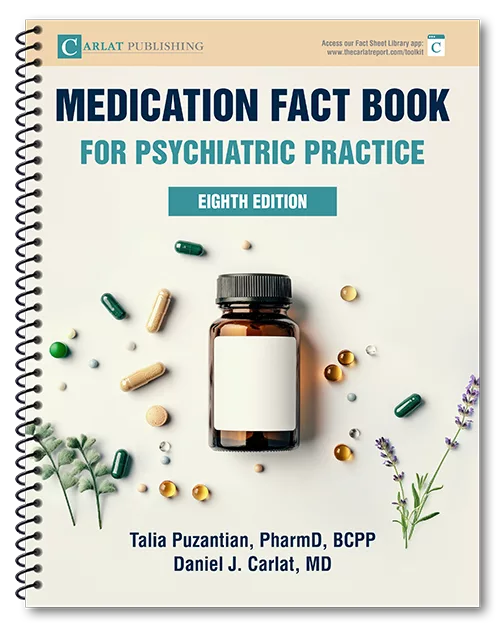Cobenfy: A New Antipsychotic
Chris Aiken, MD. Editor-in-Chief, The Carlat Psychiatry Report. Assistant Professor, NYU Langone Department of Psychiatry. Practicing psychiatrist, Winston-Salem, NC.
Dr. Aiken has no financial relationships with companies related to this material.
Last fall, the FDA approved xanomeline/trospium (Cobenfy) for adults with schizophrenia. This combo pill treats psychosis through the muscarinic (acetylcholine) system, making it the first to depart from the dopaminergic mechanisms that have dominated treatment since the discovery of chlorpromazine in the early 1950s. Compared to other antipsychotics, xanomeline/trospium has similar efficacy but brings advantages in tolerability.
How it works
Xanomeline/trospium is a two-drug combination: xanomeline, which produces the antipsychotic effect, and trospium, which blocks unwanted side effects in the body.
Xanomeline stimulates muscarinic acetylcholine receptors, especially M1 and M4. These receptors project into brain areas involved in psychosis, including the frontal cortex and striatum. Activating them may help rebalance dopamine and glutamate signaling, which are often disrupted in schizophrenia.
But activating muscarinic receptors doesn’t just affect the brain—it also impacts the gut, salivary glands, and bladder. That’s what derailed xanomeline in the 1990s, when it was tested in Alzheimer’s disease. Although it improved cognition and behavior, over half the patients dropped out due to side effects like nausea, diarrhea, and sweating (Bodick NC et al, Arch Neurol 1997;54(4):465–473).
That’s where trospium comes in. Trospium is a peripheral anticholinergic that doesn’t cross the blood–brain barrier. It blocks muscarinic receptors in the body, but not in the brain, allowing xanomeline to work centrally without causing intolerable side effects. Trospium was already FDA approved for overactive bladder, making it a convenient partner drug.
The idea of muscarinic agonists in psychosis isn’t new. As far back as 1957, the muscarinic stimulant arecoline—derived from the betel nut—was shown to reduce psychotic symptoms (Fulcher JH et al, AMA Arch Neurol Psychiatry 1957;78(4):392–395). People in South Asia have long chewed the betel nut for its stimulant effects, and some studies suggest better schizophrenia outcomes among chronic users (Coppola M and Mondola R, Nord J Psychiatry 2012;66(2):73–78).
When xanomeline showed unexpected antipsychotic effects in Alzheimer’s trials, it sparked new interest in muscarinic mechanisms for schizophrenia. Karuna Therapeutics acquired the rights to xanomeline and added trospium to solve its tolerability issues. After promising results in healthy volunteers, xanomeline/trospium moved into schizophrenia trials starting in 2021—marking the first muscarinic-targeted antipsychotic to reach FDA approval.
The clinical trials
Xanomeline/trospium’s approval was based on three randomized, double-blind, placebo-controlled trials in hospitalized adults with acute episodes of schizophrenia (total n=690). The medication worked within two weeks, with a medium effect size (0.56), similar to what we see with other antipsychotics (Kishi T et al, Pharmacopsychiatry; published online January 29, 2025; Leucht S et al, Schizophr Bull 2022;48(1):27–36). Other psychotropics were not allowed during the study (other than PRN benzodiazepines and hypnotics).
Patients were no more likely to discontinue xanomeline/trospium than placebo, but adverse effects were more common, with a relative risk of 1.3. These included dry mouth, constipation, nausea, vomiting, dyspepsia, hypertension, and elevated triglycerides.
The gastrointestinal (GI) and metabolic side effects reflect a common challenge with cholinergic–anticholinergic balancing. While trospium reduces xanomeline’s more intolerable cholinergic effects, such as sweating, salivation, and diarrhea, it introduces its own anticholinergic burden—mainly dry mouth and constipation. In practice, the trade-off appears tolerable to most patients, and rates of dropout due to side effects were similar to placebo.
Consistent with its lack of dopaminergic effects, xanomeline/trospium is not known to cause akathisia, dystonia, extrapyramidal symptoms, hyperprolactinemia, or tardive dyskinesia. It did not cause somnolence or orthostasis in the trials and did not alter weight, glucose, cholesterol, or QT interval. The usual class warnings for antipsychotics didn’t apply and were not included in the package labeling.
With its novel mechanism, it’s tempting to think that xanomeline/trospium can augment other antipsychotics. One unpublished, industry-sponsored trial has tested this, and while the strategy was safe, it led to only a small difference that was not statistically significant (ARISE, KAR-012). This needs further testing, but until we have more data, it’s best to use xanomeline/trospium as monotherapy. If used in combination with other antipsychotics, avoid the highly anticholinergic ones (eg, clozapine, olanzapine, perphenazine, thioridazine).
Nearly all the patients in these trials had tried an antipsychotic in the past, but those with treatment resistance (failing two trials) were excluded, as were those with comorbid substance use disorders. A trial in treatment-resistant schizophrenia is underway (ARISE).
Two continuation trials have looked at the long-term effects over a year in 718 patients (EMERGENT-4 and -5, presented in poster form). Though lacking a placebo control, they provide reassuring observational data. No new safety problems emerged, but 18% of patients discontinued the medication due to adverse effects (mainly GI). On average, patients lost weight over the year on the medication and saw steady improvement in their schizophrenia symptoms.
Other risks
There are a few rare risks in the FDA’s package insert that you need to know about before prescribing xanomeline/trospium. It can cause urinary retention, particularly in the elderly, and can slow down the GI tract, causing constipation and a potential interaction with the new weight loss drugs (glucagon-like peptide-1 agonists). Xanomeline/trospium has a rare association with liver toxicity and angioedema—an allergic reaction involving swelling in the face and eyes.
Cognitive effects
Xanomeline improved cognition in dementia, but will it do the same in schizophrenia? So far, the answer is uncertain. Xanomeline/trospium did not improve performance on cognitive testing in the initial trials, but it did in a secondary analysis that included only the patients with severe cognitive problems (Horan WP et al, Am J Psychiatry 2025;182(3):297–306).
Xanomeline/trospium improved negative symptoms in some trials, but negative symptoms tend to improve whenever active psychotic symptoms are treated in schizophrenia. People are more communicative and less withdrawn when they are not paranoid. When it comes to treating the chronic negative symptoms that cause so much disability in schizophrenia, most antipsychotics have failed, with the possible exceptions of cariprazine (Vraylar), clozapine, and the European antipsychotic amisulpride (Németh G et al, Lancet 2017;389(10074):1103–1113; Kim S et al, Psychiatry Investig 2021;18(10):968–976; Krause M et al, Eur Arch Psychiatry Clin Neurosci 2018;268(7):625–639).
Where it fits in the algorithm
Xanomeline/trospium is a good first-line option for acute schizophrenia. Other first-line picks include cariprazine, for its benefits in negative symptoms, and aripiprazole, for its favorable tolerability among the generic options. If patients do not respond to a first-line option (over six weeks at an adequate dose), consider olanzapine or risperidone, which have larger effect sizes than other antipsychotics. If the second antipsychotic does not work and nonadherence is not the issue, move on to clozapine.
How to use it
With a half-life of five to six hours, xanomeline/trospium is dosed twice a day. Dosing directions are in the table “Xanomeline/Trospium (Cobenfy)” above. Most patients in the trials (≥90%) reached, and tolerated, the maximum dose (125/30 mg BID). Both its levels and its half-life are increased by strong CYP2D6 inhibitors, such as fluoxetine, paroxetine, sertraline at ≥150 mg, bupropion, duloxetine, and asenapine, so you may need to titrate slower and stay at the starting dose (50/20 mg BID) if those apply.
When transitioning from another antipsychotic, it is best to cross-taper over two weeks to avoid withdrawal symptoms.
Carlat Verdict: Xanomeline/trospium brings a new mechanism of action to schizophrenia treatments. Although its efficacy is similar to other antipsychotics, its favorable tolerability moves it up in the treatment algorithm.

Newsletters
Please see our Terms and Conditions, Privacy Policy, Subscription Agreement, Use of Cookies, and Hardware/Software Requirements to view our website.
© 2025 Carlat Publishing, LLC and Affiliates, All Rights Reserved.



_-The-Breakthrough-Antipsychotic-That-Could-Change-Everything.webp?t=1729528747)



